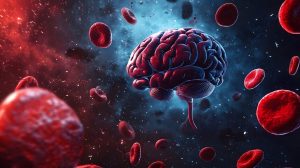In an exciting Genomic Press interview published in Brain Medicine, Dr. Sophia Shi, a doctoral student in chemistry at Stanford University, presents her groundbreaking research that is fundamentally changing our understanding of brain aging and opening up revolutionary therapeutic approaches for Alzheimer’s and related neurodegenerative diseases. A protective sugar layer on the blood vessels of the brain, once thought to be insignificant, appears to play a significant role in preventing cognitive decline. Restoring this layer has reversed damage and memory loss in aging brains, opening up a new approach to treating neurodegenerative diseases.
The Brain’s Hidden Protective Layer
Dr. Shi’s groundbreaking work focuses on the glycocalyx, a complex “forest” of sugar molecules that surrounds the endothelial cells of the blood-brain barrier. Her research, recently published in Nature, shows that this protective layer declines dramatically with age, leading to blood-brain barrier dysfunction and neuroinflammation—both important factors in cognitive decline and neurodegenerative diseases. “The glycocalyx acts like a protective shield for the blood vessels in the brain,” explains Dr. Shi. “When we restored these important sugar molecules in old mice, we saw remarkable improvements in both barrier function and cognitive function.” This discovery is the first evidence that scientists have successfully reversed age-related dysfunction of the blood-brain barrier by restoring the glycocalyx.
Outstanding Research
Dr. Shi’s path to this breakthrough began with her childhood fascination with puzzles and pattern recognition—skills that would later prove invaluable in deciphering the complex language of glycosylation. Under the guidance of Nobel Prize winner Carolyn Bertozzi and renowned neurobiologist Tony Wyss-Coray at Stanford, she succeeded in combining two different fields, glycobiology and neuroscience, to answer questions that others had overlooked.
Her interdisciplinary approach faced major challenges. How do you study molecules that are so complex in structure that they elude traditional analytical methods? What techniques can be used to capture the dynamics of glycosylation in living brain tissue? Dr. Shi’s innovative solutions to these problems illustrate the power of interdisciplinary thinking in modern biomedical research.
The significance of Dr. Shi’s work extends far beyond the laboratory. Her research has been recognized with the prestigious David S. Miller Young Scientist Award from the Cerebral Vascular Biology Conference, which honors her as one of the most promising young researchers in the field. “Post-translational modifications such as glycosylation have been neglected for far too long,” according to Shi. These modifications can completely alter the function of proteins, but researchers are only beginning to understand their role in brain health and disease.
Alzheimer’s: Combating the Causes of Neurodegeneration
The therapeutic implications of Shi’s discoveries are profound. By identifying specific mucin-type O-glycans as critical for blood-brain barrier integrity, her research provides concrete molecular targets for drug development. This precise approach could lead to treatments that combat the causes of neurodegeneration rather than just treating the symptoms. This work raises exciting questions: Can restoring the glycocalyx prevent or slow the progression of Alzheimer’s disease in humans? How early in the aging process does the breakdown of these protective molecules begin? What environmental or genetic factors influence the health of the glycocalyx throughout life? These questions will guide the next phase of Dr. Shi’s research program at Harvard University.
Preventive Medicine Approaches to Brain Health are Being Redesigned
Beyond her scientific contributions, Dr. Shi is committed to promoting diversity in science. Her dedication to mentoring and creating inclusive research environments promises to amplify her impact by inspiring the next generation of interdisciplinary scientists. Her discoveries raise fundamental questions about how we approach aging and brain disease. If glycocalyx deterioration is a common pathway in multiple neurodegenerative diseases, could targeting these molecules represent a unified therapeutic strategy? How might lifestyle factors influence glycocalyx health? These considerations could reshape preventive medicine approaches to brain health.
The transition from viewing the blood-brain barrier as a simple wall to understanding it as a dynamic, sugar-coated interface represents a paradigm shift in neuroscience. This new perspective requires innovative research approaches and could explain why previous therapeutic strategies targeting the barrier have had limited success.






